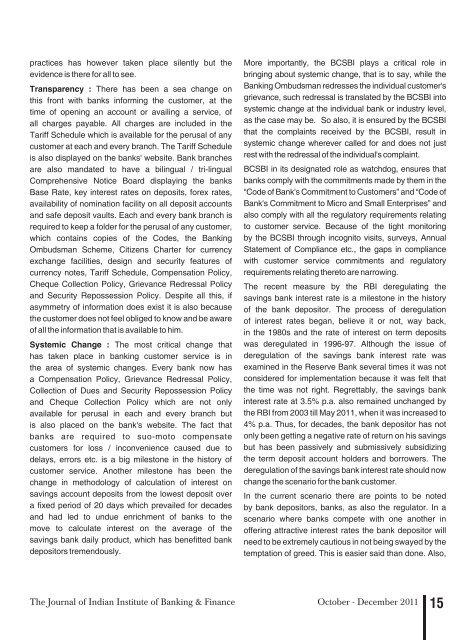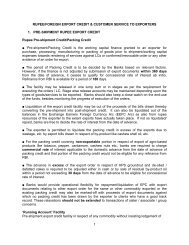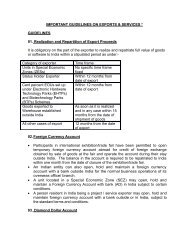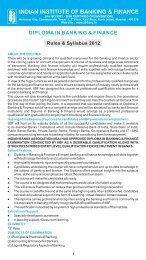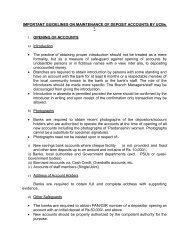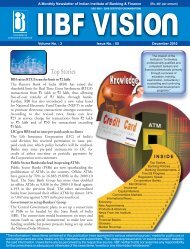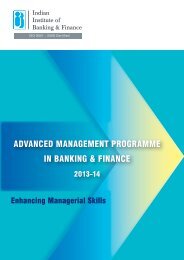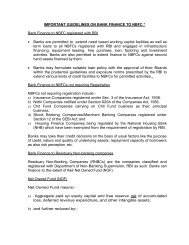Create successful ePaper yourself
Turn your PDF publications into a flip-book with our unique Google optimized e-Paper software.
practices has however taken place silently but theevidence is there for all to see.Transparency : There has been a sea change onthis front with banks informing the customer, at thetime of opening an account or availing a service, ofall charges payable. All charges are included in theTariff Schedule which is available for the perusal of anycustomer at each and every branch. The Tariff Scheduleis also displayed on the banks' website. Bank branchesare also mandated to have a bilingual / tri-lingualComprehensive Notice Board displaying the banksBase Rate, key interest rates on deposits, forex rates,availability of nomination facility on all deposit accountsand safe deposit vaults. Each and every bank branch isrequired to keep a folder for the perusal of any customer,which contains copies of the Codes, the BankingOmbudsman Scheme, Citizens Charter for currencyexchange facilities, design and security features ofcurrency notes, Tariff Schedule, Compensation Policy,Cheque Collection Policy, Grievance Redressal Policyand Security Repossession Policy. Despite all this, ifasymmetry of information does exist it is also becausethe customer does not feel obliged to know and be awareof all the information that is available to him.Systemic Change : The most critical change thathas taken place in banking customer service is inthe area of systemic changes. Every bank now hasa Compensation Policy, Grievance Redressal Policy,Collection of Dues and Security Repossession Policyand Cheque Collection Policy which are not onlyavailable for perusal in each and every branch butis also placed on the bank's website. The fact thatbanks are required to suo-moto compensatecustomers for loss / inconvenience caused due todelays, errors etc. is a big milestone in the history ofcustomer service. Another milestone has been thechange in methodology of calculation of interest onsavings account deposits from the lowest deposit overa fixed period of 20 days which prevailed for decadesand had led to undue enrichment of banks to themove to calculate interest on the average of thesavings bank daily product, which has benefitted bankdepositors tremendously.special featureMore importantly, the BCSBI plays a critical role inbringing about systemic change, that is to say, while theBanking Ombudsman redresses the individual customer'sgrievance, such redressal is translated by the BCSBI intosystemic change at the individual bank or industry level,as the case may be. So also, it is ensured by the BCSBIthat the complaints received by the BCSBI, result insystemic change wherever called for and does not justrest with the redressal of the individual's complaint.BCSBI in its designated role as watchdog, ensures thatbanks comply with the commitments made by them in the“Code of Bank's Commitment to Customers” and “Code ofBank's Commitment to Micro and Small Enterprises” andalso comply with all the regulatory requirements relatingto customer service. Because of the tight monitoringby the BCSBI through incognito visits, surveys, AnnualStatement of Compliance etc., the gaps in compliancewith customer service commitments and regulatoryrequirements relating thereto are narrowing.The recent measure by the RBI deregulating thesavings bank interest rate is a milestone in the historyof the bank depositor. The process of deregulationof interest rates began, believe it or not, way back,in the 1980s and the rate of interest on term depositswas deregulated in 1996-97. Although the issue ofderegulation of the savings bank interest rate wasexamined in the Reserve Bank several times it was notconsidered for implementation because it was felt thatthe time was not right. Regrettably, the savings bankinterest rate at 3.5% p.a. also remained unchanged bythe RBI from 2003 till May 2011, when it was increased to4% p.a. Thus, for decades, the bank depositor has notonly been getting a negative rate of return on his savingsbut has been passively and submissively subsidizingthe term deposit account holders and borrowers. Thederegulation of the savings bank interest rate should nowchange the scenario for the bank customer.In the current scenario there are points to be notedby bank depositors, banks, as also the regulator. In ascenario where banks compete with one another inoffering attractive interest rates the bank depositor willneed to be extremely cautious in not being swayed by thetemptation of greed. This is easier said than done. Also,The Journal of Indian Institute of Banking & Finance October - December 2011 15


